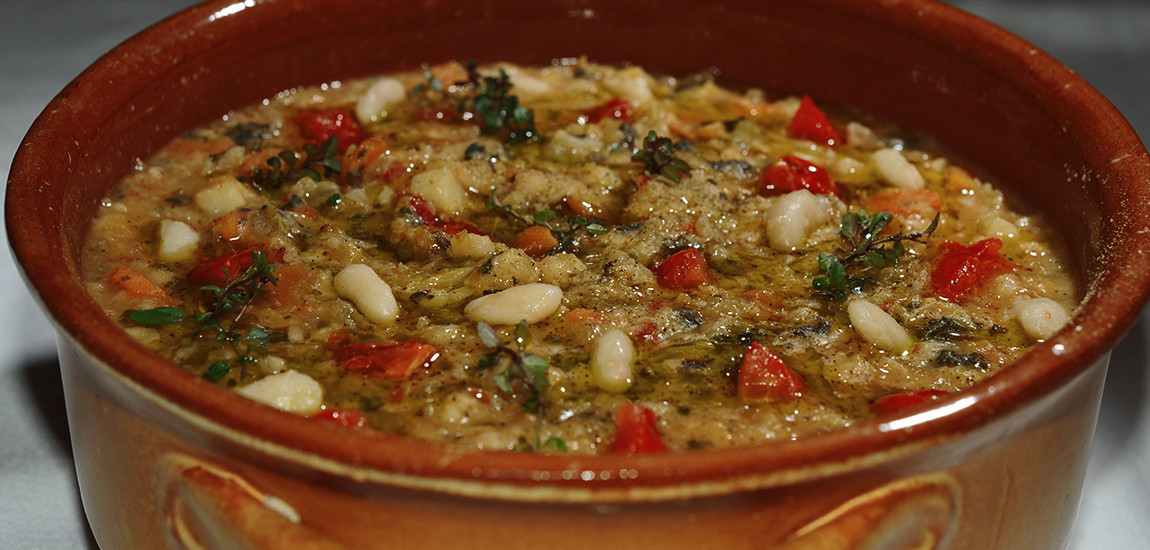
Ribollita: a symbol of Tuscan cusine
Ribollita, along with with the steak, is a symbol of Tuscan cuisine. A thick and
nutritious soup characterized by simple flavors and healthy ingredients,
perfect for cold winter days.
Already in the Middle Ages, it was the custom for the poorest families to
prepare a vegetable-based soup on Fridays, since it was a day of penance for
Catholics, and you were not allowed to eat rich foods, especially containing
meat and dairy products. You could get creative with bread, vegetables, herbs,
vegetables and pasta, instead.
Like many recipes of peasant origin, therefore, there has never been a real
recipe for this ancestor of ribollita,
nor of the ribollita itself, each
family had its own.
There are some key ingredients, though, that remain the same and without which
the ribollita would remain just a simple soup.
Black cabbage, best if picked after a winter frost so as to make it tender, cannellini beans and bread are certainly
the essential elements to prepare this dish.
The term “ribollita” indicates the procedure with which the soup is made, that
is by passing it over the fire, since it was often prepared in quantity and
served for 2 - 3 days in a row. After all, the peasant tradition has always
provided that nothing is wasted in the kitchen.
However, it seems that this term was coined recently by some restorers. It appears for the first time in the book Culinary Art in Italy by Alberto Cougnet, dated 1910, indicating a soup of beans, bread and pasta which is served for several consecutive days and warmed up several times. The concept is the right one, but closer to the original recipe is the zuppa toscana di magro alla Contadina, so called in the Artusi and described by the chef of the Savoy Hotel in Florence (between 1901 and 1909), Louis Monod in his Cuisine Florentine.
The one that we offer you today to try at home, is the recipe for true ribollita, certified after various researches and experiments, by the Delegation of Florence of the Italian Academy of Cuisine.
Ribollita
Ingredients (for 8 people)
400 grams of dried cannellini beans
400 g of black cabbage
700 gr (half head) of savoy cabbage
300 gr leaf chard
2 potatoes
1 tablespoon of tomato paste or 300 g of peeled tomatoes
400 gr of stale homemade Tuscan bread
1 onion
2 cloves of garlic
2 stalks of celery
2 carrots
thyme
Salt and pepper in grains
Extra virgin olive oil
Soak overnight the dried beans in a bowl with water.
Cook the beans in 2 liters of slightly salted cold water and keep the cooking
water. Then mash about ¾ of the beans into a puree and pour it into the cooking
broth.
Pour 8 tablespoons of oil in a large saucepan and sauté the previously chopped
onion and garlic. Once withered, add a little thyme, carrots and celery cut
into slices. Cook for a couple of minutes and add also the potatoes, the chard,
the black cabbage and the savoy cabbage cut into small pieces. Finally add the
tomato paste diluted in a little hot water (or the peeled tomatoes), salt and
cook for a few minutes.
Pour the bean broth and cook for about an hour, adding water if necessary,
before adding the remaining whole beans.
Cut the bread into thin slices, put them in the soup and mix well. Cook for a
few minutes and remove from the heat.
Let the soup rest in the fridge for a few hours, preferably the whole night,
then heat it up by adding a little oil and the "ribollita" is served!
Serve with a drizzle of olive oil and pepper.
Buon appetito!



